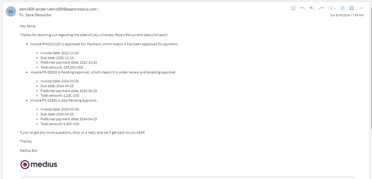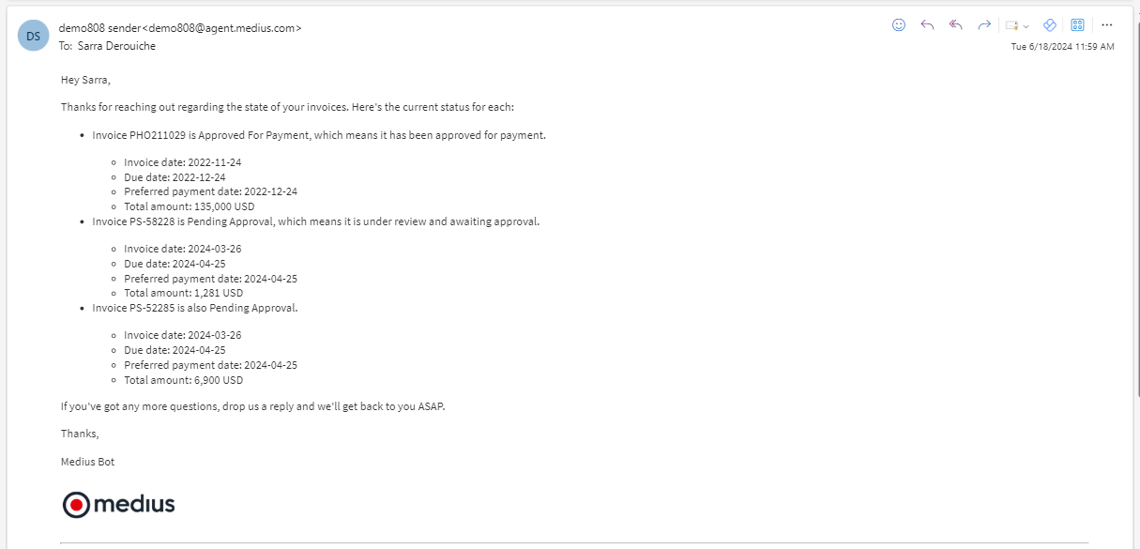Smarter DPO strategies that help you optimize cash without burning supplier bridges
- Introduction
- Improving visibility into payables
- Timing payments without compromising trust
- Early payment discounts and dynamic discounting
- Avoiding late or premature payments
- Free your AP team from endless “Where’s my payment?” emails
- DPO as a financial efficiency indicator
- Aligning DPO with broader finance goals
- Go beyond DPO with benchmarks that matter
- Why Medius supports smarter DPO at scale
Hear what's covered in this article:
Days Payable Outstanding (DPO) is one of the most influential tools finance leaders have to manage cash flow. A carefully calibrated DPO strategy can preserve liquidity, support more accurate forecasting, and strengthen relationships with suppliers. But without the right systems in place, it becomes difficult to control timing, identify savings opportunities, or avoid payment missteps that erode trust.
Medius equips AP and finance teams with the automation and visibility needed to execute smarter DPO strategies with confidence. This includes scheduling payments with precision, unlocking early payment discounts, and ensuring vendors have clarity throughout the invoice lifecycle.
Improving visibility into payables
No DPO strategy can succeed without reliable payables visibility. If invoices are buried in spreadsheets or siloed across departments, finance teams will always be a step behind. Instead of making informed decisions, they are stuck reacting to outdated information.
Medius helps eliminate these blind spots by consolidating all invoice and payment activity into a single platform. This enables teams to monitor liabilities in real time, prioritize invoices by due date or discount eligibility, and prevent issues from falling through the cracks.
A critical enabler of this is accurate invoice intake. With automated invoice capture and validation, invoices are digitized and routed immediately, cutting out delays and reducing the risk of downstream errors.
Timing payments without compromising trust
This is where DPO takes on a strategic role. The objective isn’t to delay every payment but to time payments in a way that aligns internal cash flow priorities with supplier expectations and agreed-upon terms.
Relying on manual scheduling or inconsistent approvals can create friction, especially with high-volume or strategically important suppliers. Missed deadlines, premature payments, or unclear status updates quickly strain relationships.
Medius gives finance teams the control they need to manage timing with consistency. With automated payment scheduling, payments are executed according to defined rules. Cash positions can be factored into timing decisions, and approvals can be tracked to avoid bottlenecks. This reduces last-minute surprises and improves predictability for all parties involved.
It also gives teams the ability to preserve liquidity while maintaining strong supplier relationships, without having to sacrifice one for the other.
Early payment discounts and dynamic discounting
Savings opportunities are often missed not because they aren’t available, but because they aren’t visible in time. Early payment discounts are a powerful way to reduce costs, and dynamic discounting gives suppliers flexibility to offer variable savings depending on how soon they’re paid.
By surfacing discount options as part of invoice approval, Medius makes it easy for teams to capitalize on these opportunities when cash is available. If liquidity is tight, the system can defer payments without risking discount windows.
These features help shift the perception of DPO from a simple delay tactic to a strategic tool for reducing costs, strengthening supplier relationships, and increasing flexibility across the payables process.
Avoiding late or premature payments
Some of the biggest DPO risks stem not from timing in general, but from inconsistency. A single late payment can jeopardize a key supplier relationship. Paying too early without strategic intent can tie up cash that would be better allocated toward higher-priority needs.
Automation eliminates this guesswork by aligning workflows with business rules. Once invoices are approved, Medius ensures that payments happen exactly when intended.
When suppliers don’t know what to expect, it creates unnecessary noise. Tools like automated supplier communications reduce inbound inquiries by showing vendors invoice status, expected payment dates, and any necessary next steps. This improves transparency and allows AP teams to focus on higher-value work instead of chasing clarifications.
Free your AP team from endless “Where’s my payment?” emails
Manual email triage is a hidden drain on AP performance—and a bottleneck to better DPO. Medius Supplier Conversations is an AI-powered inbox that gives suppliers real-time updates on invoice and payment status, without burdening your team.
Cut down on email noise
Reduce delays from back-and-forths
Improve supplier satisfaction
DPO as a financial efficiency indicator
DPO provides a clear lens into how disciplined and strategic an organization is in managing its payables. It reflects how reliably approvals are executed, how consistently payment terms are enforced, and how closely payment behavior aligns with working capital priorities.
Organizations with strong AP processes tend to see a DPO profile that reflects thoughtful timing, consistent execution, and high discount capture. In contrast, erratic DPO often points to process gaps or resource constraints.
Monitoring this metric alongside others like cycle time, exception rates, and discount realization helps finance leaders build a more resilient AP operation. This approach is reinforced by a broader look at AP performance indicators that go beyond the basics.
And for teams that want to audit or fine-tune their current approach, understanding how accounts payable days are calculated offers helpful context for goal setting and benchmarking.
Aligning DPO with broader finance goals
Strong DPO strategies don’t operate in isolation. They support liquidity management, enable investment timing, and reduce exposure to economic shocks. Finance leaders who align DPO with broader goals like forecasting accuracy and supplier reliability see measurable benefits across their cash operations.
As organizations evolve, their ability to manage working capital and supplier relationships efficiently becomes a differentiator. Medius helps bridge the gap between process automation and strategic decision-making, giving CFOs the tools to adapt DPO behavior as conditions change, without sacrificing control or collaboration.
That alignment between operational execution and strategic finance goals is also reflected in how modern AP contributes to overall growth planning.
Go beyond DPO with
benchmarks that matter
Tracking DPO is essential—but it’s just one piece of the performance puzzle. To lead with insight, finance teams need visibility into a full spectrum of AP KPIs, from invoice cycle times to touchless processing rates.
The Medius AP benchmark report gives you real-world performance data from companies like yours, so you can compare, calibrate, and confidently plan what’s next.
Why Medius supports smarter DPO at scale
Managing DPO is not just about lengthening payment terms. It’s about managing payment timing intelligently, using automation to protect liquidity while keeping suppliers informed and satisfied.
Medius helps teams standardize payment processes through AP automation, minimize risk, and unlock new opportunities to optimize cash flow by leveraging integration and supplier collaboration.
Finance teams using Medius can operate with greater visibility, more precision, and stronger partnerships. Book a personalized demo today to explore how your team can transform DPO into a tool for resilience and growth.









